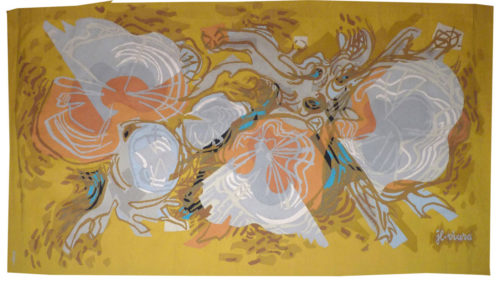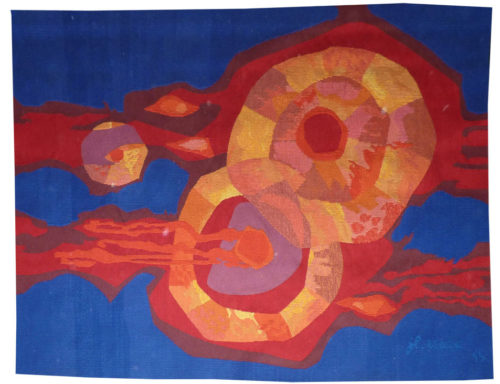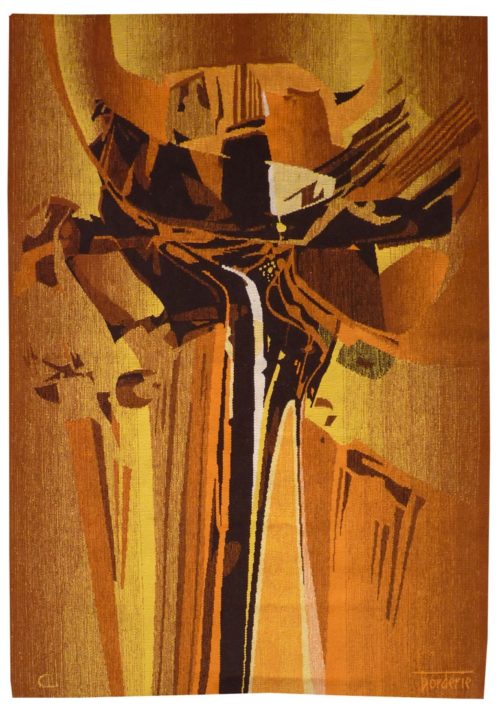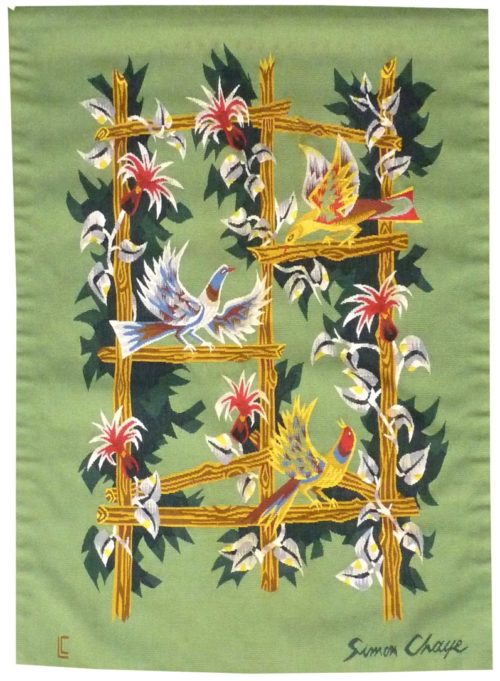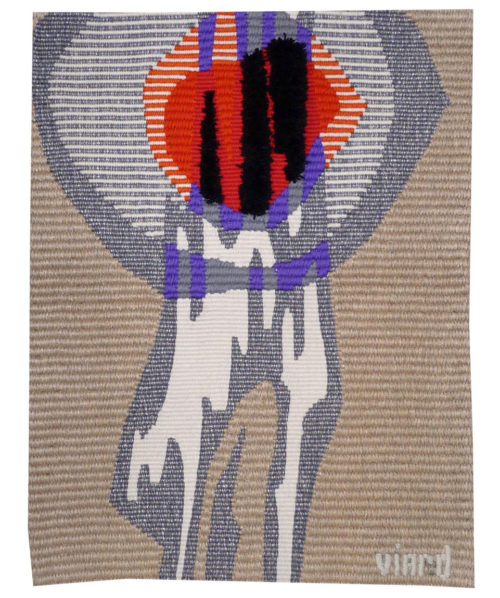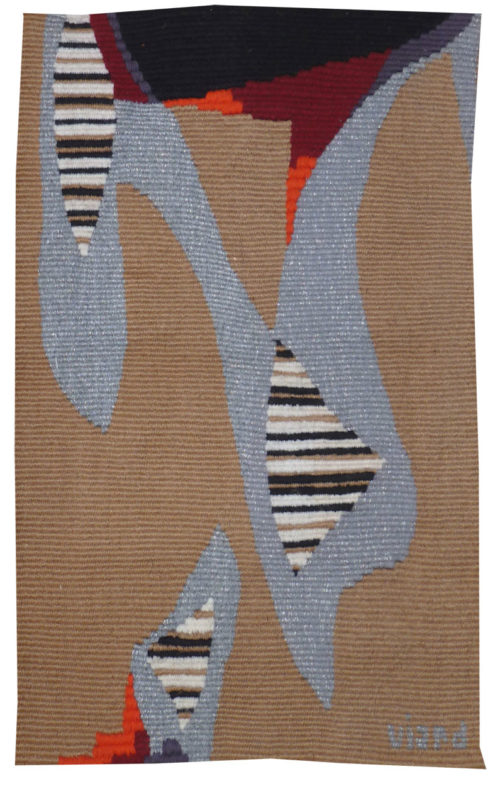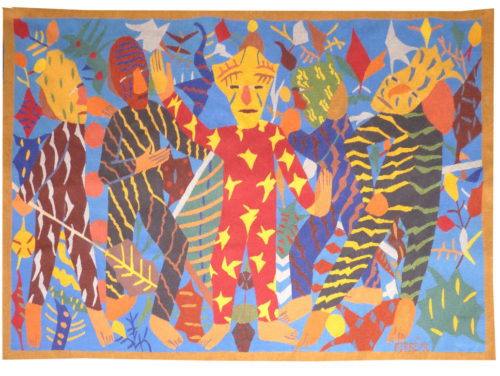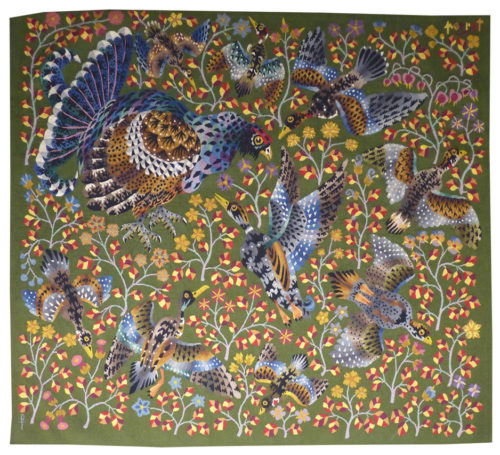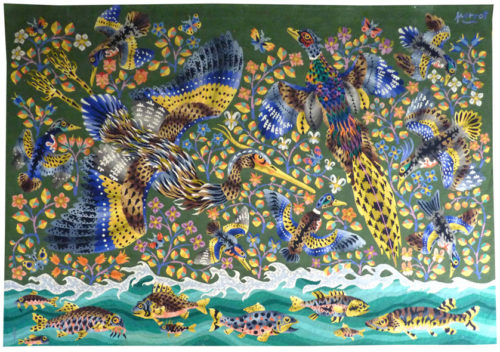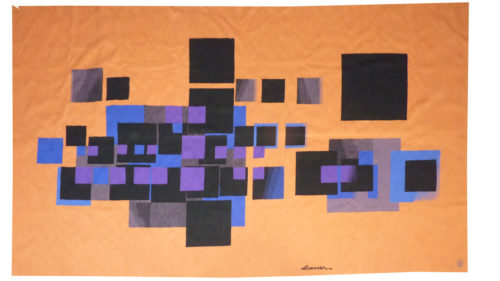-
Destins (Destinies)
Aubusson tapestry woven in the Glaudin-Brivet workshop. Complete with certificate of origin signed by the artist, n°1/6. 1974. Originally an engraver (Prix de Rome, intaglio technique in 1942), Jean-Louis Viard designed his first tapestry cartoons in the mid 1950’s. At first his work was figurative (he was collaborating at the time with Picart Le Doux), but then he evolved along the same lines as many other painter-cartoonists of the period (Matégot, Tourlière or Prassinos,...) towards abstraction. He produced scores of cartoons working up until the 2000’s, in parallel to his work as a painter and engraver, but throughout revealing a particular interest for the use of contrasting materials and textures in the tradition of the “Nouvelle Tapisserie” of which Pierre Daquin was one of the leading lights. The inspiration for his motifs, sometimes metaphysical (“Mémoires” Memories, “Destins” Destinies,…) is wide-reaching, from astronomical infinity « ténèbres solaires » solar darkness) to the microscopic (« Mutation végétale” Plant mutation) : a profuse and varied production, regularly exhibited at his home, in various public and private exhibition spaces and, most significantly, at the Salon Comparaison of which he was the curator for the Tapestry section. Origin : the artist’s workshop -
Fleur de roc (rock flower)
Aubusson tapestry woven in the Legoueix workshop. n°2/4. Circa 1970. Originally a sculptor exploiting very diverse materials (steel, concrete, clay…), Borderie came to tapestry with immense enthusiasm in the 1950’s with the weaving of his first cartoon in 1957. Receiving encouragement from Denise Majorel, he was awarded the Grand Prix National de la Tapisserie in 1962. In 1974 he was appointed as director at the Ecole Nationale des Arts Décoratifs at Aubusson but he resigned from this post shortly thereafter. He designed over 500 painted cartoons, abstracts using simple shapes, shading in a limited palette of colours and weaving with gros points. A dynamic abstraction with a limited colour scheme running from orange to brown, abstract motifs which play on the plastic effect of light passing through the colours : a classic cartoon from André Borderie. Bibliography : Exhibition catalogue André Borderie « pour l’homme simplement », Angers, Musée Jean Lurçat et de la Tapisserie Contemporaine 1998. J.J. et B. Wattel, André Borderie et la tapisserie d'Aubusson, Editions Louvre Victoire, 2018, ill. p.22 -
les oiseaux (birds)
Aubusson tapestry woven in the Legoueix workshop. n°4/6. Circa 1970. It was in 1953 that Jean Picart le Doux proposed to Chaye to become his assistant and encouraged him to design tapestry cartoons : he would produce numerous bucolic cartoons, but also views of Normandy (Mont Saint Michel, Honfleur, regattas,...) whence he came. Here birds and trelliswork cohabit in a style very reminiscent of Picart le Doux. -
Abatonn
Tapestry woven in the Saint-Cyr workshop. Complete with certificate of origin signed by the artist, n°EA1. Circa 1980. Originally an engraver (Prix de Rome, intaglio technique in 1942), Jean-Louis Viard designed his first tapestry cartoons in the mid 1950’s. At first his work was figurative (he was collaborating at the time with Picart Le Doux), but then he evolved along the same lines as many other painter-cartoonists of the period (Matégot, Tourlière or Prassinos,...) towards abstraction. He produced scores of cartoons working up until the 2000’s, in parallel to his work as a painter and engraver, but throughout revealing a particular interest for the use of contrasting materials and textures in the tradition of the “Nouvelle Tapisserie” of which Pierre Daquin was one of the leading lights. The inspiration for his motifs, sometimes metaphysical (“Mémoires” Memories, “Destins” Destinies,…) is wide-reaching, from astronomical infinity « ténèbres solaires » solar darkness) to the microscopic (« Mutation végétale” Plant mutation) : a profuse and varied production, regularly exhibited at his home, in various public and private exhibition spaces and, most significantly, at the Salon Comparaison of which he was the curator for the Tapestry section. Origin : the artist’s workshop -
Ichtyonis
Tapestry woven in the Raymond workshop. Complete with certificate of origin signed by the artist, n°EA1. Circa 1980. Originally an engraver (Prix de Rome, intaglio technique in 1942), Jean-Louis Viard designed his first tapestry cartoons in the mid 1950’s. At first his work was figurative (he was collaborating at the time with Picart Le Doux), but then he evolved along the same lines as many other painter-cartoonists of the period (Matégot, Tourlière or Prassinos,...) towards abstraction. He produced scores of cartoons working up until the 2000’s, in parallel to his work as a painter and engraver, but throughout revealing a particular interest for the use of contrasting materials and textures in the tradition of the “Nouvelle Tapisserie” of which Pierre Daquin was one of the leading lights. The inspiration for his motifs, sometimes metaphysical (“Mémoires” Memories, “Destins” Destinies,…) is wide-reaching, from astronomical infinity « ténèbres solaires » solar darkness) to the microscopic (« Mutation végétale” Plant mutation) : a profuse and varied production, regularly exhibited at his home, in various public and private exhibition spaces and, most significantly, at the Salon Comparaison of which he was the curator for the Tapestry section. Origin : the artist’s workshop -
Danseuses cambodgiennes (Cambodian dancers)
Tapestry woven at Aubusson by the Picaud workshop. Certificate of origin, n° 1/4. Circa 1965. Although somewhat overlooked now, the contribution that Maurice Ferréol made, in the 1960’s, to the design of figurative tapestry is quite remarkable. He proposed a style redolent of popular imagery where the use of pure blocks of colour exacerbates the almost childlike outline of the figures. What connects these bright and garishly coloured, masked figures to Cambodia? They are simply a pretext for a profusion of colours and motifs in the particular characteristic style of Ferréol. -
La roue (the wheel)
Aubusson tapestry woven by the Pinton workshop. Complete with certificate of origin. Circa 1970. Perrot began his career as a cartoon designer at the end of the war, making almost 500 cartoons including numerous commissions from the state, most of which were woven at Aubusson. His style which is particularly rich and decorative is eminently recognisable : a crowd of butterflies or birds, most often, stands out against a background of vegetation, reminiscent of the millefleurs tapestries (which would also inspire Dom Robert). The mediaeval inspiration of a flower-studded, khaki background, numerous birds, all the characteristic elements of Perrot’s cartoons can be found in this particular example. Bibliography: Tapisseries, dessins, peintures, gravures de René Perrot, Dessein et Tolra, 1982 -
Automne solognot (Sologne autumn)
Aubusson tapestry woven by the Pinton workshop. Complete with certificate of origin signed by the artist, n°2/6. Circa 1970. Perrot began his career as a cartoon designer at the end of the war, making almost 500 cartoons including numerous commissions from the state, most of which were woven at Aubusson. His style which is particularly rich and decorative is eminently recognisable : a crowd of butterflies or birds, most often, stands out against a background of vegetation, reminiscent of the millefleurs tapestries (which would also inspire Dom Robert). The motif of fish in profile swimming in water in the lower part of the cartoon, beneath other elements is recurrent in Lurçat’s work (for example “L’eau et le feu’, Cité de la Tapisserie, Aubusson). With Perrot the same motif gives rise to a less ambitious vision : fish and birdlife here represent, in a realistic fashion, the sports of hunting and fishing as practised in the Sologne area in Autumn. Bibliography: Tapisseries, dessins, peintures, gravures de René Perrot, Dessein et Tolra, 1982 -
Galathée
Aubusson tapestry woven by the Picaud workshop. Complete with certificate of origin signed by the artist, n° 1 of 4. 1970. Loewer designed his first cartoon in 1953 ; his early works are first figurative before turning to abstraction (like Matégot) which is exclusively geometric in Loewer’s case. He designed over 180 cartoons, most of which were woven by his friend, Raymond Picaud. Only one example of this tapestry was woven according to the catalogue raisonné, « Galathée » is representative of the artist’s style around 1970 where the recurrent design motif is the square used in superpositions. Bibliography : Claude Loewer, l’évasion calculée : travaux de 1939 à 1993, catalogue raisonné des tapisseries de 1953 à 1974, Sylvio Acatos, Charlotte Hug, Walter Tschopp and Marc-Olivier Wahler, Artcatos, 1994, n°120


